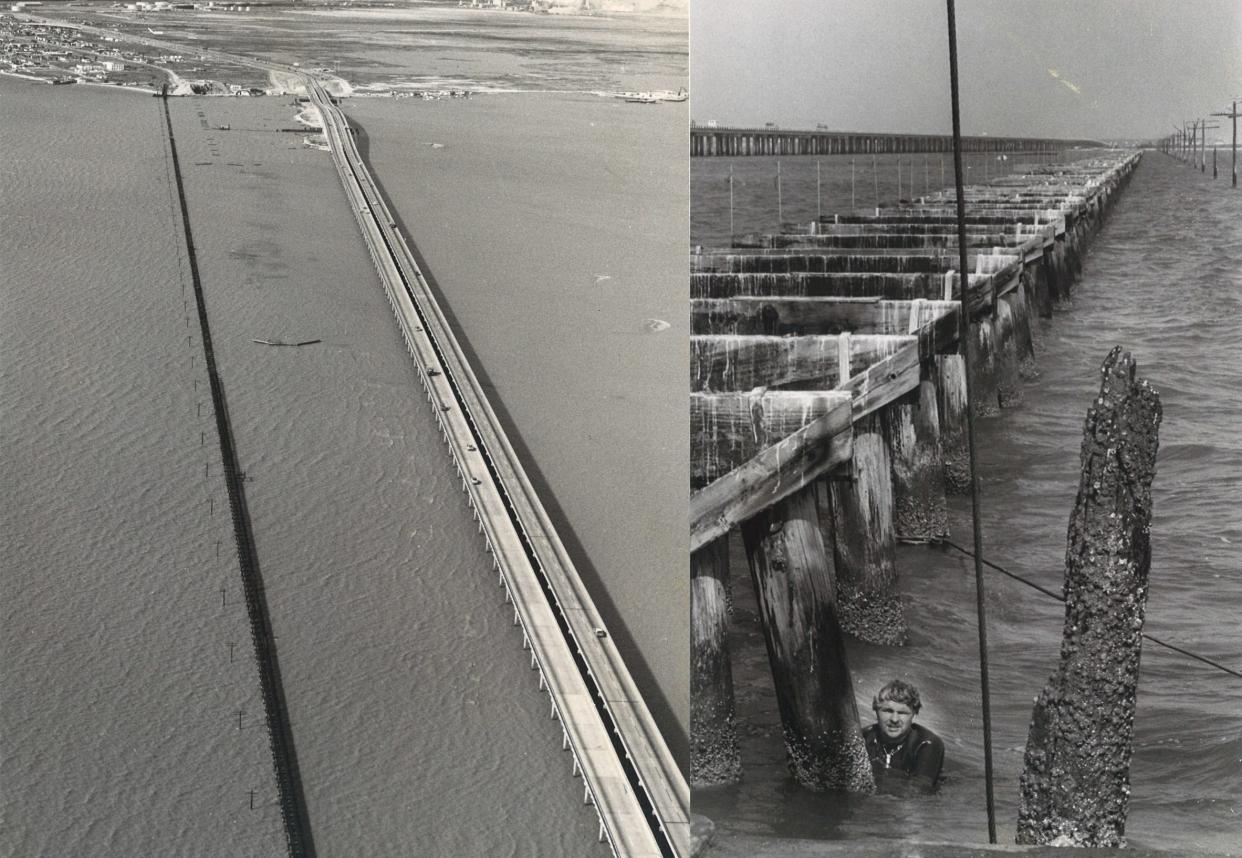#TBT: San Antonio and Aransas Pass Railway first crossed Nueces Bay in 1880s

For decades, the only remnant of the San Antonio and Aransas Pass Railway Company was trestle pilings sticking in Nueces Bay running nearly parallel to the Nueces Bay Causeway. SAAP originally built the trestle across the causeway in 1886, and it was built to last.
SAAP was chartered in August 1884, with a board of investors of nine San Antonio men. Uriah Lott, who created the Tex-Mex Railway in 1875, was hired as promoter and Mifflin Kenedy was the contractor for many of the lines built. Over two years starting in 1885, the company built 222 miles of track between Corpus Christi and San Antonio and San Antonio and Kerrville. By 1891, the company operated 688 miles of track, with a number of connections around South Texas: Kenedy to Houston; Yoakum to Waco; Gregory to Rockport; Skidmore to Alice; and Shiner to Lockhart.
Southern Pacific acquired the company in 1892, but the Railroad Commission determined in 1903 that SP violated a law prohibiting common ownership by parallel and competing lines and compelled SP to sell its SAAP stock but continue to guarantee its bonds. The SAAP expanded further, adding lines between Alice and Falfurrias; Falfurrias and McAllen; and Edinburg and Brownsville. But in 1924 Southern Pacific re-acquired the company and the SAAP became part of the Southern Pacific's Texas and New Orleans Railroad.
More: #TBT: Nueces Bay Causeway provided easier link between Corpus Christi and San Pat County
When SAAP began working to create the new rail lines in the 1880s, they hired Capt. Andrew Anderson to survey Nueces Bay for the best spot to place the trestle. What he found was miles of mud, and the only acceptable spot to build it was along the natural oyster reef that divided Nueces and Corpus Christi bays. Karankawas used the reef to make an easier crossing of the bay, and settlers eventually began using it, dubbing it the Reef Road. Now it would serve as the spot to sink the pilings for the trestle.
Historian Murphy Givens wrote of young boys walking along the trestle to go duck hunting in Portland, before the first causeway was built in 1914. When a train came along, they would drop down and sit on the wooden crossbeams until the train passed.
An ad for the SAAP in the April 26, 1924 Caller-Times advertised three daily trains between Corpus Christi and San Antonio, with “Pullman Electric Lighted Standard Sleepers and First Class Passenger Coaches,” along with “No Trouble to Answer Questions. Information Cheerfully Given.”
The last trains crossed the trestle over Nueces Bay in 1965, when Southern Pacific began using the tracks of Missouri Pacific, toward the westside of town. It was hoped the trestle could remain as a fishing pier either for Corpus Christi or Portland, but the Corps of Engineers found the plan unfeasible, and the span needed to be removed.
More: #TBT: Old Tex-Mex railway spur crossed Oso Bay into Flour Bluff
In 1967, the Goldston Co. began the arduous process of removing the pilings, some the originals from the 1880s. Many of the pilings weathered multiple hurricanes, including the 1916 and 1919 storms that swept away the causeway. But by the 1960s the pilings, either cypress or yellow pine, were beginning to rot and be churned up by movement in the bay. Goldston’s company removed all the pilings from across the mouth of the Rincon Channel to allow barge traffic to pass.
The city then hired a second company, Cole Construction Co. to remove the remaining pilings, along with the trestles. Cole stopped when a fire broke out on a trestle, plus the city was dissatisfied with the company’s use of explosives to remove the pilings. The trestle removal remained abandoned for several years until the mid-1970s, when a settlement was finally reached over a lawsuit between Southern Pacific, Cole Construction, and the state and city. The president of Beautify Corpus Christi, Jimmie King, got sick of looking at the old trestle and contacted the state to prod along the lawsuit. The city rehired the Goldston Company In 1976 to remove the last of the pilings and one of the last visible reminders of the old San Antonio and Aransas Pass Railway Company.
Allison Ehrlich writes about things to do in South Texas and has a weekly Throwback Thursday column on local history.
This article originally appeared on Corpus Christi Caller Times: San Antonio and Aransas Pass Railway first crossed Nueces Bay in 1880s

